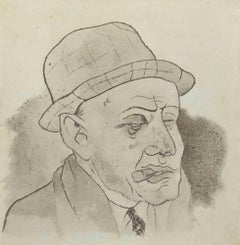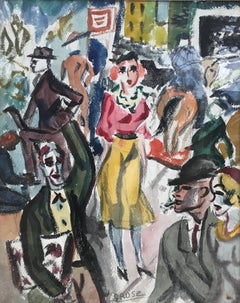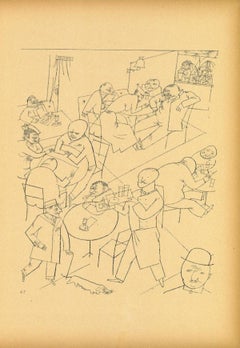George Grosz On Sale
1920s Expressionist Figurative Prints
Lithograph, Offset
1930s Expressionist Landscape Drawings and Watercolors
Paper, Watercolor
Recent Sales
Early 20th Century Dada Figurative Paintings
Mixed Media
1920s Expressionist Figurative Prints
Paper, Lithograph, Offset
1920s Expressionist Figurative Prints
Paper, Lithograph, Offset
1920s Expressionist Figurative Prints
Paper, Lithograph, Offset
1920s Expressionist Figurative Prints
Paper, Lithograph, Offset
1920s Expressionist Figurative Prints
Paper, Lithograph, Offset
1920s Expressionist Figurative Prints
Lithograph
1930s Expressionist More Art
Paper
1920s Expressionist Figurative Prints
Lithograph, Offset
1920s Expressionist Figurative Prints
Lithograph, Offset
1920s Expressionist Figurative Prints
Lithograph, Offset
1920s Expressionist Figurative Prints
Lithograph, Offset
1920s Expressionist Figurative Prints
Lithograph, Offset
People Also Browsed
1940s American Modern Landscape Paintings
Canvas, Oil
1920s Expressionist Figurative Prints
Lithograph
1940s American Realist Figurative Paintings
Canvas, Oil
1970s Modern Figurative Paintings
Gouache
1930s American Modern Landscape Drawings and Watercolors
Paper, Watercolor, Pencil
1930s American Realist Landscape Paintings
Canvas, Oil
1930s American Realist Landscape Drawings and Watercolors
Oil, Board
1930s American Realist Figurative Drawings and Watercolors
Paper, Watercolor
1940s American Modern Figurative Paintings
Masonite, Oil
1930s Figurative Paintings
Oil, Board
1940s American Realist Figurative Paintings
Canvas, Oil
1940s American Modern Figurative Drawings and Watercolors
Paper, Watercolor
Early 1900s American Realist Figurative Drawings and Watercolors
Paper, Watercolor
1930s American Modern Figurative Paintings
Oil, Board
1920s Expressionist Figurative Prints
Lithograph
1930s American Modern Figurative Drawings and Watercolors
Paper, Watercolor
George Grosz On Sale For Sale on 1stDibs
How Much is a George Grosz On Sale?
George Grosz for sale on 1stDibs
George Grosz was a German artist known especially for his caricatural drawings and paintings of Berlin life in the 1920s. He was a prominent member of the Berlin Dada and New Objectivity group during the Weimar Republic. Grosz studied drawing at the Dresden Academy (1909–11) and at the School of Arts and Crafts in Berlin (1912–14). He was in the army from 1914–15, and again for a short time in 1917, but spent the rest of the war in Berlin, where he made violently anti-war drawings, in which his main focus was attacking the social corruption of Germany (capitalists, prostitutes, the Prussian military caste, the middle class). His artworks had great impact in the Berlin Dada movement, 1917–20, and collaborated with John Heartfield and Raoul Hausmann in the invention of photomontage.
Many of Grosz’s drawings were published in albums (Gott mit uns, Ecce Homo, Der Spiesser-Spiegel, etc.), and he was subject to prosecutions for insulting the army and blasphemy. He visited the United States in 1932 to teach at the Art Students League, New York, and settled there in 1933. In the latter part of his career, he tried to establish himself as a pure painter of landscapes and still life, but also painted many compositions of an apocalyptic and deeply pessimistic kind. His role in the Berlin Dada movement affected political outlooks and artistic developments not only in Germany, but also in Russia, the Balkan nations, and parts of France.
Grosz's penetrating, darkly humorous style of drawing and his use of satire as a weapon left a deep impression on the work of his contemporaries and the artists of the next generation. Some of his works from the early 1940s, particularly during World War II, do present an allegorical and dramatic representation of Grosz's moral perspective regarding war. Additionally, some of his last pieces from 1958 were photomontages, and hearken back to his earlier Dadaist aesthetic and message, passing judgment upon consumerism and suggesting that his absorption with American culture had ended in disappointment. In 1959, Grosz sold his house and moved back to Berlin. He died shortly after his return, after a fall down the stairs.
A Close Look at Expressionist Art
While “expressionist” is used to describe any art that avoids naturalism and instead employs a bold use of flattened forms and intense brushwork, Expressionist art formally describes early-20th-century work from Europe that drew on Symbolism and confronted issues such as urbanization and capitalism. Expressionist artists experimented in paintings and prints with skewed perspectives, abstraction and unconventional, bright colors to portray how isolating and anxious the world felt rather than how it appeared.
Between 1905 and 1920, Austrian and German artists, in particular, were inspired by Postimpressionists such as Paul Gauguin and Vincent van Gogh in their efforts to strive for a new authenticity in their work. In its geometric patterns and decorative details, Expressionist art was also marked by eclectic sources like German and Russian folk art as well as tribal art from Africa and Oceania, which the movement’s practitioners witnessed at museums and world’s fairs.
Groups of artists came together to share and promote the themes now associated with Expressionism, such as Die Brücke (The Bridge) in Dresden, which included Erich Heckel, Ernst Ludwig Kirchner and Karl Schmidt-Rottluff and investigated alienation and the dissolution of society in vivid color. In Munich, Der Blaue Reiter (The Blue Rider), a group led by Wassily Kandinsky and Franz Marc, instilled Expressionism with a search for spiritual truths. In his iconic painting The Scream, prolific Norwegian painter Edvard Munch conveyed emotional turmoil through his depiction of environmental elements, such as the threatening sky.
Expressionism shifted around the outbreak of World War I, with artists using more elements of the grotesque in reaction to the escalation of unrest and violence. Printmaking was especially popular, as it allowed artists to widely disseminate works that grappled with social and political issues amid this time of upheaval. Although the art movement ended with the rise of Nazi Germany, where Expressionist creators were labeled “degenerate,” the radical ideas of these artists would influence Neo-Expressionism that emerged in the late 1970s with painters like Jean-Michel Basquiat and Francesco Clemente.
Find a collection of authentic Expressionist paintings, sculptures, prints and more art on 1stDibs.
Finding the Right Figurative-prints-works-on-paper for You
Bring energy and an array of welcome colors and textures into your space by decorating with figurative fine-art prints and works on paper.
Figurative art stands in contrast to abstract art, which is more expressive than representational. The oldest-known work of figurative art is a figurative painting — specifically, a rock painting of an animal made over 40,000 years ago in Borneo. This remnant of a remote past has long faded, but its depiction of a cattle-like creature in elegant ocher markings endures.
Since then, figurative art has evolved significantly as it continues to represent the world, including a breadth of works on paper, including printmaking. This includes woodcuts, which are a type of relief print with perennial popularity among collectors. The artist carves into a block and applies ink to the raised surface, which is then pressed onto paper. There are also planographic prints, which use metal plates, stones or other flat surfaces as their base. The artist will often draw on the surface with grease crayon and then apply ink to those markings. Lithographs are a common version of planographic prints.
Figurative art printmaking was especially popular during the height of the Pop art movement, and this kind of work can be seen in artist Andy Warhol’s extensive use of photographic silkscreen printing. Everyday objects, logos and scenes were given a unique twist, whether in the style of a comic strip or in the use of neon colors.
Explore an impressive collection of figurative art prints for sale on 1stDibs and read about how to arrange your wall art.



